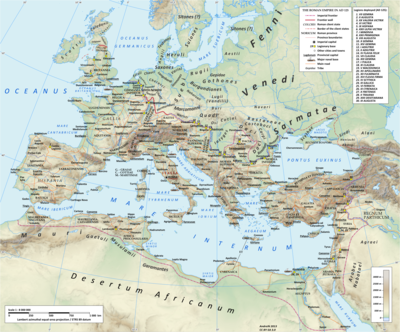Cherusci

The Cherusci were a
Name
Cherusci (Latin:
History



This section needs additional citations for verification. (May 2019) |
The Cherusci were a
As part of his
Finally, in AD 4,
The Romans encouraged the
In AD 16, Germanicus returned with eight legions and Gallic and Germanic auxiliary units, including men led by Arminius's younger brother
In the next year, Germanicus was recalled to Rome. Tacitus reports this as partially caused by the emperor's growing jealousy of the general's fame, but permitted him to celebrate a triumphal march on 26 May:Germanicus Caesar, celebrated his triumph over the Cherusci, Chatti, and Angrivarii, and the other tribes which extend as far as the Elbe.[27]
Germanicus was then moved to the Parthian border in Syria and soon died, possibly from poisoning. Arminius was killed in turn by Segestes and his allies in AD 21.
After Arminius's murder, the Romans left the Cherusci more or less to their own devices. In AD 47, the Cherusci asked Rome to send Italicus, the son of Flavus and nephew of Arminius, to become their chieftain, as civil war had destroyed their other nobility. He was initially well liked but, since he was raised in Rome as a Roman citizen, he soon fell out of favor.[28] He was succeeded by Chariomerus, presumably his son, who was defeated by the Chatti and deposed around AD 88.[29]
Tacitus (56–c. 120) writes of the Cherusci:
Dwelling on one side of the Chauci and Chatti, the Cherusci long cherished, unassailed, an excessive and enervating love of peace. This was more pleasant than safe, for to be peaceful is self-deception among lawless and powerful neighbours. Where the strong hand decides, moderation and justice are terms applied only to the more powerful; and so the Cherusci, ever reputed good and just, are now called cowards and fools, while in the case of the victorious Chatti success has been identified with prudence. The downfall of the Cherusci brought with it also that of the Fosi, a neighbouring tribe, which shared equally in their disasters, though they had been inferior to them in prosperous days.[30]
The later history of the Cherusci is unattested.[citation needed]
See also
- List of Germanic peoples
- Battle of Teutoburg Forest
Notes
References
Citations
- ^ Reallexikon der Germanischen Alterturmskunde. Vol. 4. 1981. p. 430 ff., s.v. "Cherusker"; cf. also Rudolf Much; Herbert Jankuhn; Wolfgang Lange (1967). Die Germania des Tacitus. Heidelberg: Winter. p. 411.
- ^ Jacob Grimm (1853). Geschichte der Deutschen Sprache. Vol. 2 (2nd ed.). Leipzig. p. 426.
{{cite book}}: CS1 maint: location missing publisher (link) - ^ Reallexikon der Germanischen Alterturmskunde. Vol. 1. 1973. pp. 420–421, s.v. "Arminius".
- ^ Beard 2007, p. 108.
- ISBN 9780191735257,
Cherusci, a Germanic people, living around the middle Weser. They are the best known of the Germanic opponents of the Romans in the 1st cent. AD.
- Commentaries on the Gallic War, 6.10.
- ^ Pliny, Nat. Hist., 4.28.
- ^ Smith, William (1854). Dictionary of Greek and Roman Geography.
- ^ OCLC 835973451.
- Rom. Hist.
- ^ Roberts 1996, pp. 65–66.
- ^ Ozment 2005, pp. 20–21.
- ^ Tacitus, Ann., 1, 51.
- ^ The Works of Tacitus, Vol. 1: The Annals, London: Bohn, 1854, Book 1, Ch. 60, & Book 2, Ch. 25.
- ^ Wells 2003, p. 204-205.
- ^ Seager 2008, p. 63.
- ^ Wells 2003, pp. 204–205.
- ^ Wells 2003, pp. 196–197.
- ^ Tacitus & Barrett 2008, p. 39
- ^ Wells 2003, p. 206
- ^ Wells 2003, p. 206.
- ^ Tacitus & Barrett 2008, p. 57.
- ^ Tacitus & Barrett 2008, p. 58.
- ^ Seager 2008, p. 70.
- ^ Tacitus & Barrett 2008, pp. 58–60.
- ^ Dyck 2015, p. 154.
- ^ Tacitus, Annals, 2.41
- ^ Tacitus, Annals, 11.16.
- ^ Cassius Dio, Epitome, 67, 5.
- ^ "Tac. Ger. 36". Perseus Project. Retrieved 2013-12-31.
- Ptolemy, Geogr.2, 11, 10.
Bibliography
- ISBN 978-0-674-02613-1
- Dyck, Ludwig Heinrich (2015), The Roman Barbarian Wars: The Era of Roman Conquest, Pen and Sword, ISBN 9781473877887
- Seager, Robin (2008), Tiberius, John Wiley & Sons, ISBN 9780470775417
- Tacitus, Cornelius (2008), Barrett, Anthony (ed.), The Annals: The Reigns of Tiberius, Claudius, and Nero, Oxford University Press, ISBN 9780192824219
Further reading
- Tacitus, Cornelius and Michael Grant, The Annals of Imperial Rome. New York: Penguin Books, 1989.
- Caesar, Julius et al. The Battle for Gaul. Boston: D. R. Godine, 1980.
- Wilhelm Zimmermann, A Popular History of Germany (New York, 1878) Vol. I
- Ptolemy, "Geography"
- Max Ihm, Cherusci. In: Paulys Realencyclopädie der classischen Altertumswissenschaft (RE). volume III,2, Stuttgart 1899, Sp. 2270–2272.
- Ralf Günther Jahn, Der Römisch-Germanische Krieg (9–16 n. Chr.). Diss., Bonn 2001.
- Peter Kehne, Zur Lokalisierung, Organisation und Geschichte des Cheruskerstammes. In: Michael Zelle (Hrsg.), Terra incognita? Die nördlichen Mittelgebirge im Spannungsfeld römischer und germanischer Politik um Christi Geburt. Akten des Kolloquiums im Lippischen Landesmuseum Detmold vom 17. bis 19. Juni 2004. Philipp von Zabern Verlag, Mainz 2008, ISBN 978-3-8053-3632-1, pages 9–29.
- Gerhard Neumann, Reinhard Wenskus, Rafael von Uslar, Cherusker. In: Reallexikon der Germanischen Altertumskunde(RGA). 2. Auflage. volume 4, Walter de Gruyter, Berlin – New York 1981, pages 430–435.
- Ozment, Steven (2005). A Mighty Fortress: A New History of the German People. New York: Harper Perennial. ISBN 978-0-06093-483-5.
- Roberts, J. M. (1996). A History of Europe. New York: Allen Lane. ISBN 978-0-96584-319-5.
- Oberst Streccius, Cherusker. In: Bernhard von Poten (Hrsg.): Handwörterbuch der gesamten Militärwissenschaften. volume 2, Bielefeld/Leipzig 1877, page 235.
- Wells, Peter S. (2003). The Battle That Stopped Rome. Norton. ISBN 978-0-393-32643-7.
- . Encyclopædia Britannica. Vol. 6 (11th ed.). 1911. p. 89.
